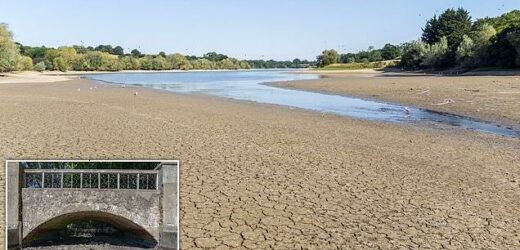What happens once a drought is declared? Will I be hit by a hosepipe ban? How long will it last? Your questions answered as government takes action
A drought was declared in parts of England today following the driest summer for 50 years.
The conditions, which have almost completely deprived some areas of rainfall all summer, have prompted the National Drought Group to move parts of the South West, parts of southern and central England, and the East of England into official drought status.
It is the first drought declared in the UK since 2018 – although that one was rapidly brought to an end by heavy rain – but despite the threat of torrential downpours and thunderstorms on Monday, much of southern England is unlikely to see significant rain until September.
The move is likely to lead to water use restrictions for households and businesses. It will also put pressure on water companies to do more to conserve supplies after a number of major leaks in recent weeks wasting millions of gallons of water.
So what is the significance of today’s move, and what changes could we start to see?
Who decides when to declare a drought?
The Environment Agency’s National Drought Group declares when there is a drought.
The NDG is made up of representatives from the Department for Environment Food and Rural Affairs, water companies, the Environment Agency, the National Farmers’ Union, Natural England, Consumer Council for Water, water services regulator Ofwat, Water UK and the Drinking Water Inspectorate, as well as the Angling Trust and the Rivers Trust.
What makes it a drought?
There is no single definition for a drought or set of measures that must be met. Instead, the group looks at rainfall, water supplies in rivers, reservoirs and lakes and temperature forecasts.
If they decide the factors have combined in a certain way to warrant a warning, they will raise the alarm and offer a prediction of how severe the drought will be and how long it will last.
An aerial view of Wessex Water’s Sutton Bingham Reservoir near Yeovil in Somerset, where the water level has dropped significantly
The most recent EA data showed rainfall totals for August have ranged from 12% of the long-term average in north east England to 0% in southeast and south west England.
Meanwhile river flow data revealed almost 90% of measuring sites were showing below normal readings, with 29% classed as “exceptionally low”.
It comes after the driest July on record for some areas and the driest first half of the year since 1976.
Four water companies, Welsh Water, Southern Water, Thames Water, and South East Water have all imposed hosepipe bans, while Yorkshire Water has announced a ban will start on August 26.
The heat and dry conditions have also taken their toll on agriculture.
Hosepipe bans have already been announced for around 17million people – and another 15million could soon join them.
Parts of southern England had the driest July since records began, and reservoir levels have fallen to their lowest levels in the last 30 years.
The fact a drought has been officially announced makes it highly likely more areas could follow suit.
How long will it last?
Dry conditions are expected to continue until October.
Even after rain starts falling it takes weeks and months for reservoirs and underground aquifers to fill up again, meaning Britain could stay in drought status for quite some time.
How do drought conditions impact Britain?
In a moderate drought, water supplies come under stress, wildlife habitats are harmed, wildfires break out and farmers suffer lower crop yields, according to the National Drought Group.
Prolonged dry conditions are already causing problems for crops like potatoes, apples, hops, broccoli and sprouts, and there are fears Britain risks a looming vegetable shortage.
Jack Ward, chief executive of the British Growers Association, said Britain ‘could be in a major deficit position’, where domestic supplies cannot meet demand. He said: ‘The temperatures we are seeing here are being replicated around Europe so European production sites are facing similar challenges. This could lead to less product and less choice.’
Long dry periods are problematic for wildlife because they can reduce the amount of food available to animals. Fish may also be affected by lower oxygen levels in the water.
The impacts of a more serious drought include the ‘failure of public and private water supplies’, the National Drought Group says. Along with ‘widespread’ wildfires, the failure of crops and plants for fodder would increase food prices and worsen shortages of certain produce.
A dried up part of the River Stour, which runs through Patrixbourne and Bridge near Canterbury
The extremely dry summer of 1975 saw sheep, pigs and calves die in the high temperatures, while milk yields fell and lambs and cattle took longer to fatten, according to a Royal Society paper.
Crops suffered not only from a lack of water but also from an increase in pests and diseases.
What restrictions could water companies bring in?
Once a drought is declared, the National Drought Group can limit the amount of water companies can take from rivers and ensure there are suitable plans for dealing with drought incidents.
In some situations, the group will perform an ’emergency fish rescue’ from drying-out bodies of water. It can also stop businesses using spray irrigation as well as advising the public how to conserve water.
There could also be hosepipe bans and further restrictions on non-essential water use, including car washes and swimming pools. There would be ‘prolonged’ restrictions on canal and river navigation due to low water levels, and companies that consume large amounts of water would be forced to apply for permits to continue doing so.
A severe drought could lead to water rationing and the introduction of standpipes or mobile water tanks. A huge emergency response would include the convening of COBRA, the government’s emergency committee.
Water companies could impose rationing at certain times of day and the introduction of standpipes or mobile water tanks. The permit regime would also be substantially toughened up to protect public water supplies. All other amber restrictions would be further strengthened.
Source: Read Full Article




